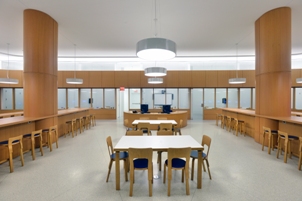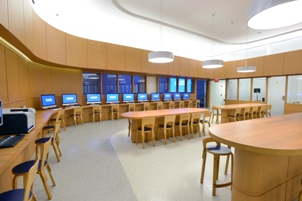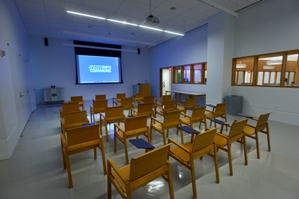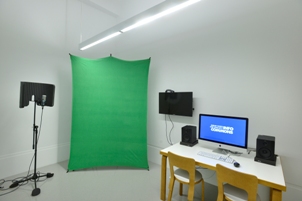 The recently-restored entrance to Brooklyn Public Library’s (BPL) Central Library at Grand Army Plaza is something to behold. Otherwise unadorned, the building’s art-deco façade curves inward, highlighting a giant portico, where visitors walk between two 50-foot pylons and a 40-foot gateway featuring 15 bronze, sculpted panels that will remind patrons of great works of American literature.
The recently-restored entrance to Brooklyn Public Library’s (BPL) Central Library at Grand Army Plaza is something to behold. Otherwise unadorned, the building’s art-deco façade curves inward, highlighting a giant portico, where visitors walk between two 50-foot pylons and a 40-foot gateway featuring 15 bronze, sculpted panels that will remind patrons of great works of American literature.
For many years, the million annual visitors who stepped through this entrance and into the building’s soaring lobby would find themselves staring at a scruffy, carpeted area offering a hodgepodge of unrelated services ranging from public computers to popular DVDs to microfilm readers.
But after a year of extensive remodeling, BPL on Tuesday unveiled its Central Library’s Shelby White and Leon Levy Information Commons area—a new public space designed to complement the building’s history while pointing toward the library’s future.

The area features ten 27-inch iMacs and 15 PC stations outfitted with premium design and productivity software. (All photos courtesy of BPL)
Made possible by a $3.25 million grant from local philanthropist Shelby White, the 5,500 square foot area “is really what I consider the nucleus around which our future service delivery strategies will revolve,” Richard Reyes-Gavilan, BPL’s Chief Librarian, told a group of librarians gathered from throughout the region to preview the space last week.
If this is the case, then BPL’s future will be focused on offering its users spaces where they can be productive and creative, and get work done individually, in small groups, or in classroom settings.
Stepping into the InfoCommons area from the lobby, patrons will see 10 new 27-inch iMacs lining the left side of the room. All are loaded with leading design software, including Adobe Creative Suite Master Collection, Final Cut Pro, and ProTools. On the right side of the room are 15 similarly-outfitted PC stations. In between, as many as 70 laptop users can be accommodated with seating, outlets, and wireless access.
Rather than Internet browsing or social media use, the area is geared toward patrons who are “working on anything that takes time to create,” Reyes-Gavilan told LJ. The library has a separate computer lab on the third floor that will continue to serve casual users, he explained.

The area features one classroom and seven meeting rooms
Off of the main area, users will find one large classroom that seats up to 36 people, as well as seven smaller meeting rooms of various sizes, designed to accommodate groups of two to 14. And, there’s a fully-outfitted recording booth that BPL plans to use for oral history projects, podcasts, and other recordings.
The meeting areas, the high-end software, and the modern classroom were all incorporated in response to “critical needs that this building has had for a long, long time,” Reyes-Gavilan told LJ.
Achieving visual continuity with the lobby of this historical landmark was not an inexpensive endeavor. Architect Toshiko Mori replaced the carpeting with terrazzo tile. Tables, desks, and the paneling covering the walls and two central pillars are all made from rift-cut white oak—wood typically used for high-end cabinets and doors. The result is a design with simple, understated elegance that complements the lobby while still evoking productivity.
“Industriousness feeds everything we did around this space—the furniture, the lighting,” Reyes-Gavilan said. “It’s not like a college student center with beanbag chairs.”

A recording booth and green screen will be used for podcasts, oral history projects, and other endeavors
During his brief speech to attendees at last week’s event, Reyes-Gavilan emphasized that he wanted librarians and their colleagues throughout New York City and the surrounding region to view the InfoCommons as a shared space.
“The reason we thought it was so important to have so many people who are not from Brooklyn Public Library here is because we really can’t stress enough that this is a space that we want to share.” He envisions “a professional development playground, having people who have got great ideas for programs that they want to have take place in this space.”
As a statement about BPL’s future, the InfoCommons seems to speak primarily to the creative class that has taken root in Brooklyn during the past two decades. But BPL’s recently released strategic plan indicates that the library plans to emphasize services to all of the borough’s varied demographics going forward, whether they are graphic designers, recent immigrants, or impoverished families.
Achieving these goals could require the library to sell several under-utilized branches, and use the proceeds to repair and upgrade other, heavily used branches, according to a story published this week in the Wall Street Journal.
Describing the condition of many branches as varying “from mediocre to poor,” BPL President and CEO Linda Johnson told WSJ that the library has estimated it will need $230 million for long-postponed repairs across the system’s 60 locations, not including $8 million for damage caused by superstorm Sandy. Meanwhile, system-wide circulation rose 77% from 2002 through 2011, and visits are up 41%.


